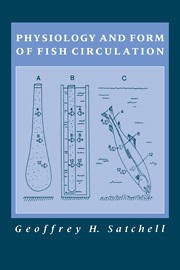Book contents
- Frontmatter
- Contents
- Preface
- 1 Introduction
- 2 The Heart
- 3 The peripheral circulation
- 4 The blood
- 5 Haemopoiesis and phagocytosis - the mononuclear phagocytic system
- 6 Circulation through special regions
- 7 Retial counter-current systems: flow–diffusion–concentration
- 8 Venous return and venous pumps
- 9 The autonomic nervous system
- 10 The response to exercise
- 11 The response to hypoxia
- 12 Myxine, a speculative conclusion
- References
- Appendix of popular and scientific names
- Index
10 - The response to exercise
Published online by Cambridge University Press: 05 February 2012
- Frontmatter
- Contents
- Preface
- 1 Introduction
- 2 The Heart
- 3 The peripheral circulation
- 4 The blood
- 5 Haemopoiesis and phagocytosis - the mononuclear phagocytic system
- 6 Circulation through special regions
- 7 Retial counter-current systems: flow–diffusion–concentration
- 8 Venous return and venous pumps
- 9 The autonomic nervous system
- 10 The response to exercise
- 11 The response to hypoxia
- 12 Myxine, a speculative conclusion
- References
- Appendix of popular and scientific names
- Index
Summary
Introduction
In Chapter 6 the location and circulation of the red and white myotomal muscles were described; red muscle, it was noted, was aerobic and provided for sustained swimming, whereas white muscle was poorly circulated, depended largely on glycolysis and was used only in short bursts, for fast swimming. It is necessary to define these terms more precisely.
The speed of swimming, U, is related to the length L of the fish; Thompson (1917) and later Brett (1965) concluded that it was proportional to the length of the fish raised to the 0.5 power. U is expressed in cm sec−1; L sec−1 is also used. Swimming is arbitrarily defined as sustained, prolonged, or burst. Sustained swimming has to be able to be maintained for long periods, i.e. more than 200 min, without fatigue and is the swimming used when fish forage, school, migrate, or, as in the tunas, which lack a swimbladder, have to swim fast enough to counteract their negative buoyancy. Sustained swimming speeds vary, depending on fish length; Beamish (1978) gives values, for Atlantic salmon 12–25 cm sec−1, for trout 0.2–26 cm sec−1, for pike 5.5 cm sec−1.
Prolonged swimming is observed over shorter periods, 20–200 min, and ends in fatigue. Such speeds are most frequently measured in laboratory experiments, when fish are swum in flumes and raceways. The symbol Ucrit is used to indicate the maximum speed that can be maintained over a given period, often 1 h. Ucrit for Atlantic salmon is 70–100 cm sec−1, for trout 48–70 cm sec−1, for pike 148 cm sec−1.
- Type
- Chapter
- Information
- Physiology and Form of Fish Circulation , pp. 158 - 169Publisher: Cambridge University PressPrint publication year: 1991



